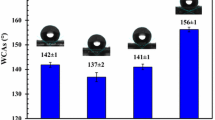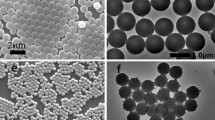Abstract
Silica-based methyltrimethoxysilane (MTMS) offers unique properties as an alternative material for hydrophobic surfaces. In this study, SiO2 obtained through the MTMS precursor with various concentrations of cetyltrimethylammonium bromide (CTAB) 0.75 wt%, 1.5 wt%, and 2.25 wt% were prepared by sol-gel method to modify and improve a hydrophobic surface. With the addition of CTAB, particle sizes are more extensive, and peak diffractions shift to a lower angle according to scanning electron microscope (SEM) images and X-ray diffraction (XRD), respectively. Fourier transform infrared (FTIR) demonstrated Si-O-Si asymmetric stretching bonds. Then, the samples were coated on steel plate substrates by the dip-coating method. Based on atomic force microscope (AFM) analysis, surface roughness was larger because of the presence of CTAB. Furthermore, water contact angle (WCA) was measured to characterize hydrophobicity using distilled, deionized, and seawater media. The WCA of the samples was more significant with the increase of CTAB content. The sample dropped to seawater medium possesses the largest WCA with a magnitude of 126.1 ± 0.8°. Because the samples with CTAB content coated on steel plate substrates own hydrophobicity, they are useful for drag reduction application on the ship’s hull coating.
Graphical Abstract

Schematic illustration of the coating structure and the fabricated samples with different media such as distilled, deionized, and seawater.
Highlights
-
SiO2-based MTMS using CTAB modifications was synthesized by the sol-gel method.
-
Modified SiO2 was coated on a steel plate substrate with commercial paint by the dip-coating method.
-
The hydrophobicity of the samples was compared to the different concentrations of CTAB.
-
The water contact angle was measured by comparing different media such as distilled, deionized, and seawater.
-
The morphology obtained was spherical-like particles.








Similar content being viewed by others
References
Vareda JP, Maximiano P, Cunha LP et al. (2018) Effect of different types of surfactants on the microstructure of methyltrimethoxysilane-derived silica aerogels: a combined experimental and computational approach. J Colloid Interface Sci 512:64–76. https://doi.org/10.1016/j.jcis.2017.10.035
Yao C, Dong X, Gao G et al. (2021) Microstructure and adsorption properties of MTMS/TEOS co-precursor silica aerogels dried at ambient pressure. J Non Cryst Solids 562:120778. https://doi.org/10.1016/j.jnoncrysol.2021.120778
Nadargi D, Gurav J, Marioni MA et al. (2015) Methyltrimethoxysilane (MTMS)—based silica—iron oxide superhydrophobic nanocomposites. J Colloid Interface Sci 459:123–126. https://doi.org/10.1016/j.jcis.2015.08.018
Motlagh NV, Derogar S, Bagherzade G, Gholami R (2022) Preparation and characterization of anti-stain self-cleaning coating on ceramic. Mater Chem Phys 276:125278. https://doi.org/10.1016/j.matchemphys.2021.125278
Xie W, Xiao X, Zhao Y, Zhang W (2017) Preparation of hydrophobic SiO2@(TiO2/MoS2) composite film and its self-cleaning properties. J Coat Technol Res 14:1147–1158. https://doi.org/10.1007/s11998-016-9907-0
Chen B, Zhang R, Fu H, et al. (2022) Efficient oil—water separation coating with robust superhydrophobicity and high transparency. Sci Rep 1–8. https://doi.org/10.1038/s41598-022-06220-9
Dashairya L, Barik DD, Saha P (2019) Methyltrichlorosilane functionalized silica nanoparticles-treated superhydrophobic cotton for oil–water separation. J Coat Technol Res 16:1021–1032. https://doi.org/10.1007/s11998-018-00177-z
Li J, Zhao Z, Zhang Y, et al. (2017) Facile fabrication of superhydrophobic SiO 2 -coated mesh used for corrosive and hot water/oil separation. J Sol-Gel Sci Technol 299–307. https://doi.org/10.1007/s10971-016-4283-x
Wang J, Chen J, Cao S et al. (2009) A facile route to prepare ZnO super-hydrophobic surface with hierarchical structure. Mater Chem Phys 117:183–186. https://doi.org/10.1016/j.matchemphys.2009.05.033
Ferrari M, Benedetti A (2015) Superhydrophobic surfaces for applications in seawater. Adv Colloid Interface Sci 222:291–304. https://doi.org/10.1016/j.cis.2015.01.005
Zhang D, Wang L, Qian H, Li X (2016) Superhydrophobic surfaces for corrosion protection: a review of recent progresses and future directions. J Coat Technol Res 13:11–29. https://doi.org/10.1007/s11998-015-9744-6
Chobaomsup V, Metzner M, Boonyongmaneerat Y (2020) Superhydrophobic surface modification for corrosion protection of metals and alloys. J Coat Technol Res 17:583–595. https://doi.org/10.1007/s11998-020-00327-2
Hosseini S, Savaloni H, Gholipour Shahraki M (2019) Influence of surface morphology and nano-structure on hydrophobicity: a molecular dynamics approach. Appl Surf Sci 485:536–546. https://doi.org/10.1016/j.apsusc.2019.04.236
Cacciotti I, Nanni F, Campaniello V, Lamastra FR (2014) Development of a transparent hydrorepellent modified SiO2 coatings for glazed sanitarywares. Mater Chem Phys 146:240–252. https://doi.org/10.1016/j.matchemphys.2014.03.005
Zhao X, Li Y, Li B et al. (2019) Environmentally benign and durable superhydrophobic coatings based on SiO(2) nanoparticles and silanes. J Colloid Interface Sci 542:8–14. https://doi.org/10.1016/j.jcis.2019.01.115
Rao AV, Latthe SS, Nadargi DY et al. (2009) Preparation of MTMS based transparent superhydrophobic silica films by sol-gel method. J Colloid Interface Sci 332:484–490. https://doi.org/10.1016/j.jcis.2009.01.012
Haapanen J, Aromaa M, Teisala H et al. (2015) Binary TiO2/SiO2 nanoparticle coating for controlling the wetting properties of paperboard. Mater Chem Phys 149:230–237. https://doi.org/10.1016/j.matchemphys.2014.10.011
Öztürk A, Bayrakçeken Yurtcan A (2020) Investigation of synergetic effect of PDMS polymer hydrophobicity and polystyrene-silica particles roughness in the content of microporous layer on water management in PEM fuel cell. Appl Surf Sci 511:145415. https://doi.org/10.1016/j.apsusc.2020.145415
Karthick B, Maheshwari R (2008) Lotus-inspired nanotechnology applications. Resonance 13:1141–1145. https://doi.org/10.1007/s12045-008-0113-y
Yuan X, Xu L, Pan H et al. (2021) Eco-friendly approach for preparation of water-based superhydrophobic silica aerogels via ambient pressure drying. Mater Res Express 8:015021. https://doi.org/10.1088/2053-1591/abda66
Ardekani SR, Rouh Aghdam AS, Nazari M et al. (2019) A new approach for preparation of semi-transparent superhydrophobic coatings by ultrasonic spray hydrolysis of methyltrimethoxysilane. Prog Org Coat 135:248–254. https://doi.org/10.1016/j.porgcoat.2019.05.033
Latthe SS, Rao AV (2012) Superhydrophobic SiO2 micro-particle coatings by spray method. Surf Coat Technol 207:489–492. https://doi.org/10.1016/j.surfcoat.2012.07.055
Dou W, Wang P, Zhang D, Yu J (2016) An efficient way to prepare hydrophobic antireflective SiO2 film by sol-gel method. Mater Lett 167:69–72. https://doi.org/10.1016/j.matlet.2015.12.146
Liu H, Zhang Y, Ma Z, Zhang H (2022) Robust surface with thermally stable hydrophobicity enabled by electrosprayed fluorinated SiO2 particles. J Coat Technol Res 19:347–353. https://doi.org/10.1007/s11998-021-00540-7
Zhao X, Li Y, Li B et al. (2019) Environmentally benign and durable superhydrophobic coatings based on SiO 2 nanoparticles and silanes. J Colloid Interface Sci 542:8–14. https://doi.org/10.1016/j.jcis.2019.01.115
Liu P, Niu L, Tao X et al. (2019) Facile preparation of superhydrophobic quartz sands with micro-nano- molecule hierarchical structure for controlling the permeability of oil and water phase. Colloids Surf A 569:1–9. https://doi.org/10.1016/j.colsurfa.2019.02.035
Sohrabi B, Mansouri F, Khalifan SZ (2019) The study of glass superhydrophobicity by modified SiO2- hexadecyltrimethoxysilane (SiO2-m-HDTMS) nanoparticles and mixture of surfactants. Prog Org Coat 131:73–81. https://doi.org/10.1016/j.porgcoat.2019.02.010
Eshraghi E, Biotechnol JPE, EE S et al. (2017) Effect of SiO2 nanoparticle and sodium-dodecyl-sulfate surfactant on surface properties: wettability alteration and IFT reduction. J Pet Invest 8:6–10. https://doi.org/10.4172/2157-7463.1000
Wang G, Yang J, Shi Q (2011) Preparation of transparent ultrahydrophobic silica film by sol-gel process. J Coat Technol Res 8:53–60. https://doi.org/10.1007/s11998-010-9270-5
Wu G, Yu Y, Cheng X, Zhang Y (2011) Preparation and surface modification mechanism of silica aerogels via ambient pressure drying. Mater Chem Phys 129:308–314. https://doi.org/10.1016/j.matchemphys.2011.04.003
Martinez-calderon M, Haase TA, Novikova NI et al. (2022) Turning industrial paints superhydrophobic via femtosecond laser surface hierarchical structuring. Prog Org Coat 163:106625. https://doi.org/10.1016/j.porgcoat.2021.106625
Yan Y, Cui M, Jiang W et al. (2017) Drag reduction in reservoir rock surface: Hydrophobic modification by SiO2 nanofluids. Appl Surf Sci 396:1556–1561. https://doi.org/10.1016/j.apsusc.2016.11.209
Ferrari M, Benedetti A (2015) Superhydrophobic surfaces for applications in seawater. Adv Colloid Interface Sci 222:291–304. https://doi.org/10.1016/j.cis.2015.01.005
Ou J, Wang F, Li W et al. (2020) Methyltrimethoxysilane as a multipurpose chemical for durable superhydrophobic cotton fabric. Prog Org Coat 146:105700. https://doi.org/10.1016/j.porgcoat.2020.105700
Wang Z, Yang A, Tan X et al. (2020) A veil-over-sprout micro-nano PMMA/SiO 2 superhydrophobic coating with impressive abrasion, icing, and corrosion resistance. Colloids Surf A 601:124998. https://doi.org/10.1016/j.colsurfa.2020.124998
Ul Haq E, Zaidi SFA, Zubair M et al. (2017) Hydrophobic silica aerogel glass-fibre composite with higher strength and thermal insulation based on methyltrimethoxysilane (MTMS) precursor. Energy Build 151:494–500. https://doi.org/10.1016/j.enbuild.2017.07.003
Maggay IV, Wu CJ, Guo HR et al. (2021) Superhydrophobic SiO2/poly(vinylidene fluoride) composite membranes for the gravity-driven separation of drug enantiomers from emulsions. J Memb Sci 618:118737. https://doi.org/10.1016/j.memsci.2020.118737
Durães L, Maia A (2015) Effect of additives on the properties of silica based aerogels synthesized from methyltrimethoxysilane (MTMS). J Supercrit Fluids 106:85–92. https://doi.org/10.1016/j.supflu.2015.06.020
Zhang J, Liu Z, Liu J et al. (2016) Effects of seed layers on controlling of the morphology of ZnO nanostructures and superhydrophobicity of ZnO nanostructure/stearic acid composite fi lms. Mater Chem Phys 183:306–314. https://doi.org/10.1016/j.matchemphys.2016.08.031
Zhou H, Sun J, Wu X et al. (2013) Tailored morphology and controlled structure of bimodal mesopores silicas via additive ammonia amount in the TEOS-CTAB-H2O system. Mater Chem Phys 140:148–153. https://doi.org/10.1016/j.matchemphys.2013.03.013
Nabil M, Mahmoud KR, El-Shaer A, Nayber HA (2018) Preparation of crystalline silica (quartz, cristobalite, and tridymite) and amorphous silica powder (one step). J Phys Chem Solids 121:22–26. https://doi.org/10.1016/j.jpcs.2018.05.001
Munasir, Triwikantoro, Zainuri M, Darminto (2015) Synthesis of SiO2 nanopowders containing quartz and cristobalite phases from silica sands. Mater Sci Pol 33:47–55. https://doi.org/10.1515/msp-2015-0008
Shao Z, Luo F, Cheng X, Zhang Y (2013) Superhydrophobic sodium silicate based silica aerogel prepared by ambient pressure drying. Mater Chem Phys 141:570–575. https://doi.org/10.1016/j.matchemphys.2013.05.064
Gao N, Yan YY, Chen XY, Zheng XF (2010) Superhydrophobic composite films based on THS and nanoparticles. J Bionic Eng 7:S59–S66. https://doi.org/10.1016/S1672-6529(09)60218-3
Acknowledgements
The author would like to acknowledge and give a great thank you to the Advanced Material Laboratorium Department of Physics, Institut Teknologi Sepuluh Nopember (ITS) for supporting this work.
Author information
Authors and Affiliations
Contributions
All authors contributed to the study conception and design. Material preparation, data collection, and analysis were performed by LS, YM, Amilia, Sudarsono, MZ, and Darminto. The first draft of the manuscript was written by LS and all authors commented on previous versions of the manuscript. All authors read and approved the final manuscript.
Corresponding author
Ethics declarations
Conflict of interest
The authors declare no competing interests.
Additional information
Publisher’s note Springer Nature remains neutral with regard to jurisdictional claims in published maps and institutional affiliations.
Rights and permissions
Springer Nature or its licensor (e.g. a society or other partner) holds exclusive rights to this article under a publishing agreement with the author(s) or other rightsholder(s); author self-archiving of the accepted manuscript version of this article is solely governed by the terms of such publishing agreement and applicable law.
About this article
Cite this article
Silvia, L., Mughayyirah, Y., Amilia et al. Surface modification of SiO2-based methyltrimethoxysilane (MTMS) using cetyltrimethyl ammonium bromide (CTAB) on the wettability effects through hierarchical structure. J Sol-Gel Sci Technol 108, 228–236 (2023). https://doi.org/10.1007/s10971-023-06202-x
Received:
Accepted:
Published:
Issue Date:
DOI: https://doi.org/10.1007/s10971-023-06202-x




